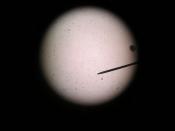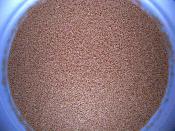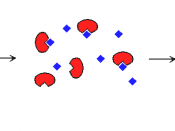Nikul Patel2004-02-22
Immobilised Enzymes Coursework
(See graph for Results)
Interpretation of results
It would seem that the yeast suspension was very much faster acting than the immobilised yeast
The yeast suspension reached a distant of four hundred and thirty squares over the 30 minute period, whereas the immobilised yeast only reached a distance of one hundred ad thirty six squares.
Also within the first twelve minutes the yeast suspension had reached 126 squares, whereas the yeast immobilisation had only reached 20 squares.
The gradient of the starch suspension is also very much steeper than that of the yeast that was immobilised in capsules. This must mean that the suspended yeast had a much higher and faster reaction rate.
This must be due to the increased surface area that the yeast suspension provides, as it can mix and spread out amongst the substrate much easier and ore efficiently than the immobilised enzyme.
This increased surface area provides a higher probability of an enzyme and substrate cumin into contact, and forming an enzyme-substrate complex. (When a substrate binds onto an enzymes active site and activates the enzyme to perform either anabolism or catabolism).
Whereas the immobilised yeast has less surface area (and available contact) therefore making it less likely to create an enzyme-substrate complex.
But the advantage of using immobilised enzymes is their easily reusable quality; little or no effort is required to separate the enzyme from the end product. The one big disadvantage is shown in the graph and results, that it is much slower than the suspended enzymes. The implications for industry are that the slower the process is he lower the output must become, which damages profits. But the recyclability of the immobilised enzymes would cut costs thus increasing profit margins.
Evaluation of Practical Work.
This experimental method must...


